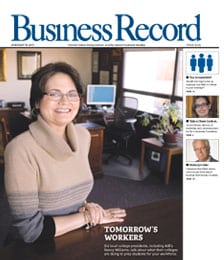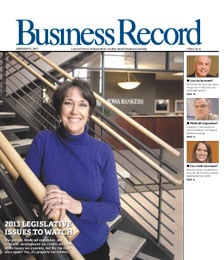A catalyst for development

Stand on the corner of 15th Street and Grand Avenue, and you’ll get a much different feel for downtown depending on whether you’re looking east or west.
To the west, Meredith Corp.’s campus with its sculptured lawns beckon. Turn 180 degrees, and in stark contrast there’s a view of aging buildings and parking lots.
Just two years from now, city officials and business leaders are betting on a much different view — a vista of open park space linking the western edge of downtown with the core business district, with tree-lined sidewalks connecting the Temple for the Performing Arts, the John and Mary Pappajohn Center for Higher Education and the new Des Moines Public Library. The dapple of water splashing on rocks will be heard from a small canal passing through what will be known as Western Gateway Park. There may also be a fountain and some public artworks.
Bringing more people to that area of downtown and creating a more vibrant streetscape is sorely needed, said Art Slusark, a Meredith spokesman.
“We bring people here from out of town and they ask, ‘Where is everybody?’” he said.
“What we’re really hoping for is additional retail spaces,” Slusark said. “When (you consider) we’ve got about 1,000 people here at Meredith and about 2,000 at ING, it’s an ideal area for some development of some retail services that would really benefit our employees and make us feel more connected to downtown.”
Anchored on its eastern edge by ING Groep NV’s corporate offices at 10th Street and to the west by Meredith’s campus, the five—square-block redevelopment project has already attracted significant corporate investment in adjoining office space by Meredith, ING and Allied Insurance, and will continue to be a catalyst for development as it moves forward, say officials.
The city, in partnership with the Downtown Community Alliance, anticipates the entire Gateway West project, first envisioned 12 years ago, can be completed by spring 2006.
“That’s our goal and I’m sticking to it,” Deputy City Manager Rick Clark said in an interview with the Business Record last week.
The city and the DCA have each budgeted approximately $6 million to complete the project, which includes the acquisition of most of the properties between 13th and 15th streets and demolition of the existing buildings following relocation of the remaining businesses.
The $6 million is already included in the city’s capital budget. Additionally, the DCA says it is committed to its share, which will be made as annual payments once the city’s bonding process begins.
“We’ve made the commitment and it will happen,” said Susan Ramsey, a spokeswoman for the DCA and the Greater Des Moines Partnership. Ramsey said the Partnership had initially pledged to find $5 million in private investments from the business community, but that effort “languished,” and it decided to take on the financial commitment directly.
Encouraging development
“Certainly the motivation behind the project is to create a ‘central park’ environment so it enhances the environment downtown so we can better market adjacent properties for development,” she said.
One of the Partnership’s goals has been to identify companies that will want to expand or relocate adjacent to the Gateway park, both north of Grand Avenue and south of Locust Street, said Ramsey, who declined to specify how much progress has been made.
“I think the current construction of the library and the Pappajohn Center are raising a lot of attention, interest and motivation for people to be looking at it,” she said. “I’m very optimistic about reaching the goals we have set out.”
Among the owners of parcels within a few blocks north of the Gateway project are Iowa Health-Des Moines and Principal Financial Group Inc. However, representatives of those companies said they have no immediate plans to develop the properties.
Because there are several parking lots off Grand north of the future park, those “become great locations for corporate expansions, maybe some mixed-used developments where you’d have some residential, office and retail development,” Clark said. “These locations along the north side of Grand are now ripe for some very significant development.”
South of the park off Locust, development will probably be more centered around existing structures, Clark said.
Virginia Noble, owner of Beggar’s Banquet on University Avenue, opened a second restaurant on the ground floor of the Arlington-Hallett Apartments two years ago specifically because of the Gateway West project. The building at 1301 Locust St., along with the Temple for the Performing Arts to the east, are the only two existing buildings that will be retained at the park.
It’s kind of exciting, and we’re glad to be down here,” she said.
For other business owners within the future park space that will have to move, the feelings are mixed, depending on whether they’ve been able to make better arrangements, said Jerry King, a manager at King Delivery Service, 1406 Grand Ave.
“Right now I’m really neutral,” said King, whose family business has been located at various Grand Avenue locations for the past 80 years. “I’m hoping to better my situation, but how do you better your location from Grand Avenue? So I feel like it’s going to be a step backwards.”
King said there’s been a lack of communication and follow-through by the city with the business owners that has resulted in the project dragging on for 10 years. The high design fee attached to the park also bothers him, he said.
Bill Anderson, a Des Moines architect and lead designer on the project team, said every attempt has been made over the past four years to make the project a collaborative process, with about 300 meetings having been held during that time.
The result of those meetings has been a consensus that Gateway West will be a mix of appropriate commercial spaces with newly built civic structures, but consist primarily of about 10 acres of park space, he said. Working with his firm are two landscape architecture firms, Zimmer Gunsel Frasca Partnership and Dunbar Jones PLC; a mechanical and electrical engineering firm, KJWW Engineering Consultants; a civil engineering firm, Snyder and ssociates Consultants; a cost consultant, Stecker-Harmsen Inc.; and a fountain designer, Hydro Dramatics Inc. The design costs for the project, about $900,000, are paying for the entire design team, not just his costs, said Anderson
Clark said the tax revenues lost from moving small businesses off the land has been minimized by efforts to relocate these companies within the city; about 75 percent of the businesses that have been relocated so far have moved within the city and so are still on the tax rolls, he said.
Gateway West was an important factor behind several corporate expansions, Clark said, the most recent being the addition of another building by Wells Fargo Financial. In total, the projects have added approximately 1.6 million square feet in commercial space in the vicinity of Gateway West. “That equates to about $160 million in taxable value,” he said. In contrast, the city is probably losing about $5 million in taxable value from the businesses that will be moved out, he said.
Energizing the area
The roots of the Gateway West project extend back to some early planning conducted by architect Mario Gandelsonas, an Ivy League professor who in a study for the city floated the idea of a large park for this area of downtown, Clark said. Later, Meredith’s 230,000-square-foot expansion began discussion of the idea of linking that company’s campus with the core downtown district, he said.
One aspect of the park that will make it successful is that there will be activities within it, including the library, higher education center, restaurants and apartments that will attract people to it, Anderson said.
“The Temple for Performing Arts is an excellent example of what a facility can do to activate an area,” he said. “When the library and higher ed center are completed, that’s just going to further activate the area. With the Arlington-Hallett Apartments and the restaurant on the ground floor, and the potential for more residential units on the north side of Grand, you’re seeing something that’s active all the time.”
The park itself will have many amenities built in, including the same type of buried drainage system found on sports fields that will make large group activities possible, even after heavy rains. The green areas will be fully sprinklered for irrigation, and a central promenade through the park will have benches and pedestrian lighting.
“This is definitely a catalyst for development in the area,” Anderson said. “It’s also a gateway to the downtown from the west. It’s an amenity not just for the city but for people who want to develop around it. And I think development won’t just occur north of Grand Avenue; I think development will occur beyond that. This will be a major focal point for years to come. We’re building a park that’s going to last for many decades. It’s going to evolve for many uses.”







